


The pug is a delightful companion, affectionate, playful, outgoing and extremely responsive. Originally bred in ancient China, the breed was prized by royalty for its loyal and loving nature. Pugs are very bright and learn quickly. They are typically friendly with children and strangers, and tend to get along well with other animals.
Breed-related concerns
Every dog breed carries a distinct set of genetic advantages and health risk factors. The following are the most common diseases found in the Pug breed. Hopefully, your pug will not face these problems. However, early detection and preventive healthcare can make all the difference in helping your dog live a longer, happier life (see breed-related disease descriptions below).
Puppy (birth to 1 year)*
Adult (1 to 6 years)*
Senior (7 years and older)*
Breed-related disease descriptions
Listed in alphabetical order. *Please note that these common diseases can occur earlier or later in the dog’s life.
Brachycephalic airway disease. Common in dog breeds with short noses. Abnormalities include narrow nostril openings, an abnormally long soft palate, an abnormal voice box (larynx), and a small trachea (windpipe). Signs include noisy and difficult breathing, snoring, reluctance or inability to exercise, blue membranes, and collapsing episodes.
Corneal disease. The cornea is the front, clear window of the eye. A variety of diseases can affect the clearness of the cornea and also cause eye pain. This breed is more predisposed because they have “bug eyes” that stick out more than other breeds. Signs may include squinting or frequent blinking, rubbing eyes, excessive tearing or discharge from the eyes or bloodshot eye.
Demodicosis. Dermatitis (skin inflammation) caused by a parasite, the Demodex mite. Signs include patchy to widespread hair loss, change in skin color (may be pink, red and sometimes even dark), scaliness and crusting.
Patella luxation. The kneecap slips out of place occasionally leading to pain and lameness. Symptoms include holding the affected limb up off the ground, not wanting to exercise and lameness of hind legs.
Pug encephalitis. Progressive and fatal inflammation of the brain of pug dogs. The cause is unknown. Signs include depression, lethargy, abnormal behavior, blindness and seizures.
Obesity. Pugs have a tendency to want to eat everything in sight. This leads to the pet being overweight and the extra weight can lead to several health problems.
Retained deciduous teeth. Delayed shedding of deciduous (“baby”) teeth can cause adult teeth to grow in crooked or out of place. This can cause food to become entrapped and left untreated, can lead to severe gum disease.
Skin fold dermatitis. Inflammation of skin due to rubbing and infection of skin folds (wrinkles). Signs may include redness, odor, crusting and sores in skin folds.
Help your dog live a longer, healthier life. Ask your veterinarian about a breed-related preventive health plan.